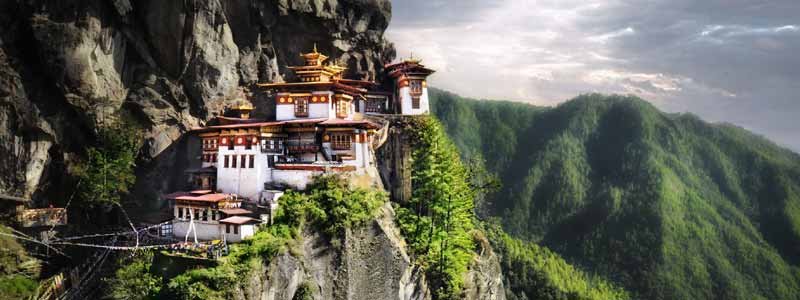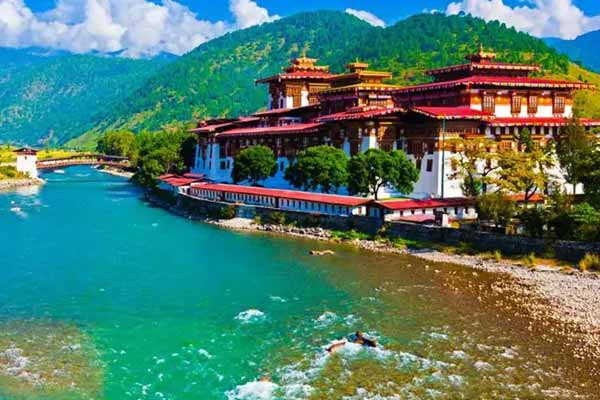Bhutan Tour Guide is not an ordinary place, it has been the most loved country by tourists. Be its colourful culture or enigmatic mountain, the tourist places in Bhutan has always attracted tourists from across the world. The country of rolling hills and charming culture always exudes the charm that cannot be missed. Delightful people, dense forest, gigantic mountains and exclusive cuisine, always give a delightful experience. Bhutan is a place to experience and feel its warmth that will stay in your for lifelong.It evokes a sense of emotion that retains its opacity to keep you hooked. Bhutan is surprising and its traditions are visible Bhutan Tour Guide.
A flight to Paro will be surely the most part of your journey overlooking the enigmatic snowy mountain calling you to explore them. Bhutan is blessed with hilltop monasteries that brings out the peace which you desire to have during your visit. These monasteries are century old and are still strong in terms of construction and solace which is offered. Some of these monasteries are listed in the UNESCO Heritage List and introduces to the long-lasting religion. Bhutan is known for its colourful festivals that have been celebrated since the time of kingdom. These festivals showcase the culture and present the story that is hidden beneath.
Masked people, colourful clothes and music are enough to keep you hooked and create interests. Then there are textiles and handicrafts that showcase the true art of the people here. Bhutan Tour Guide is not only about festivals and monasteries, but also of thrilling mountain activities, river rafting and archery competitions which are the part of Bhutan travel. All these certainly makes Bhutan the Gross National Happiness country giving a different picture altogether. So pack your bags and head to this happy country, to visit the most awaited tourist places in Bhutan.

History of Bhutan
Archaeological evidence suggests this area was inhabited as far back as 2000 BC. Tibetan king Songtsen Gampo introduced Buddhism to Bhutan in the seventh century AD, extending the Tibetan Empire into the region and ordering the construction of two Buddhist temples in the Paro area.
Until the early 17th century, Bhutan Tour Guide was essentially a patchwork of small, warring fiefdoms, and then the Tibetan lama and military leader Ngawang Namgyal, who had fled religious persecution in Tibet, unified the area. To defend the country against periodic Tibetan advances, Namgyal built a network of impregnable dzongs (fortresses) and promulgated the Tsa Yig, a legal code that helped to bring local lords under centralized control. Many dzongs still exist and are active centers of district administration and religion.
Through the British East India Company, the British entered Bhutan Tour Guide in the 18th century as part of its colonial expansion into India, China and the region as a whole. The British remained involved in the country’s affairs for the ensuing two hundred-plus years. After centuries of internal struggles, civil wars and conflicts with neighboring peoples, during which the British backed certain leaders and factions, Bhutan chose a king in 1907. The nation settled into an agreement that gave the British control of Bhutan’s foreign affairs.
In 1953, the king established the 130-member National Assembly in order to promote a more democratic form of governance, and the country eventually changed from an absolute to a constitutional monarchy.
It was only in 1999 that the country lifted its ban on television and the Internet and began to open up more to the outside world. In 2005, Bhutan began to implement a new constitution, and in 2007 and 2008, it held its first national parliamentary elections. After opening its country to commercial tourism in 1974, Bhutan Tour Guide welcomed 287 tourists that year. Every year, as the draw of this vibrant, unspoiled country increased, more and more people made the journey. Today, over a quarter-million people visit Bhutan annually.
Interesting facts about Bhutan:
- Bhutan is known as the “Land of the Thunder Dragon”, because of the violent thunderstorms that growl over the country’s valleys
- Bhutan is the first country to measure growth and performance through “Gross National Happiness” instead of Gross National Product
- Bhutan outlawed tobacco in 2004 and it’s rare to see people smoking on the streets
- The national sports of Bhutan are archery and darts
- Thimphu has no traffic lights – just white gloved traffic officers
- Gangkhar Puensum is the highest mountain in Bhutan. It is so sacred that no one has climbed its peak
Places to visit in Bhutan
Bhutan Tour Guide, the last Himalayan Kingdom, is a country where you would find happiness prevailing across! Sharing international boundaries with India and China, this picturesque piece of heaven is shrouded by the mystical Himalayas, cuddled with pictorial plains and magical sub-alpine mountains. Amidst all these miraculous beauties, one would find a range of scenic places to visit in Bhutan.
1. Phuentsholing
As you enter the Land of Thunder Dragons through the Jaigaon-Phuentsholing entry point, you will feel a uniqueness all around you! The pristine beauty of this Bhutanese town, its livelier ambience, and friendly locals will surely create a deep impression in your mind and soul.
Often revered as the ‘Gateway to Bhutan’, Phuentsholing is among the most popular holiday destination in the country. The fact that this town is located adjacent to the Indian town of Jaigaon, Indian national often flee to this town to enjoy day-outs and family picnic during the months of December, January, and February.
2. Thimphu
In addition to being the capital city of Bhutan Tour Guide, Thimphu is also known for its perfect mix of cultural values, indigenous traditions, and modern vibes. The largest city in the country, it is also touted as the most developed and modern destination in Bhutan.
Shrouded with some of the most ancient monasteries, dzongs, and other point of interests, Thimphu also proves to be an ideal destination if you want to sit back and laze around while enjoying the best of Bhutan’s weather.
3. Punakha
If you ask anyone about what is so special about Punakha, you are likely to get introduced its kaleidoscopic weather conditions and natural beauty. A hidden gem in Western Bhutan Tour Guide, this scenic valley enjoys a warm summer and an enjoyable winter.
This gorgeous valley entices visitors with its rich and diverse history, array of ancient dzongs, and friendly locals. Punakha Dzong, which is known to be one of the oldest dzongs in Bhutan is located in this pictorial valley. While in here, visitors should also make it to its local rice fields, which is often famed as one of the most scenic treats to the eyes.
4. Paro
If you happen to Google about Bhutan Tour Guide, there are high probabilities that you would be shown exhilarating images of the Tiger’s Nest Monastery in Bhutan. Well, if you have ever come across any such images, you should know that you already had a glimpse of how beautiful Paro Valley would be!
Located at a lofty elevation of 7,200ft, this picturesque valley is an esteemed tourist destination in Bhutan’s tourism map. Along with the Tiger’s Nest Monastery, this valley is also the home to more than 150 noted sacred sites and tourist points. As you enter Bhutan, make sure that your itinerary has a tour to the scenic Paro Valley; else, you will miss out a slice of heaven in Bhutan.
5. Bumthang
Comprising of four of the most stunning vicinities in the entire country – Choekhor, Chumey, Tang, and Ura, Bumthang Valley takes all the pride of being one of the most tranquil tourist destinations in Bhutan. A proud valley that sits at an altitude of 2,600-4,500m, this valley in Central Bhutan is a picture-perfect destination for leisure seekers, history diggers, honeymooners, and others.
Visitors yarning for some secluded moments and peace of mind, should visit Bumthang without even thinking twice. Its magical weather, tourist attraction points, and other tourist options would surely keep you engrossed with all the required fun, frolic, and peace of mind.
Best time to visit Bhutan
Bhutan’s calendar is filled with different seasons in different regions. You may need to do your research specifically for a particular region. However, there is one chunk of the year that is uniformly pleasant – from October to December – clear skies and sunny days with a hint of chill make the perfect weather to visit Bhutan.
How to reach Bhutan
By Air: Bhutan only has one international airport, based in Paro. The domestic airport is found in south central Bhutan Tour Guide (Gelephu Airport). You can catch a flight via Druk Air, which operates direct flights from Kolkata, Delhi, Bangkok, Kathmandu and Dhaka to Paro. The closest airport in India is Bagdogra Airport in West Bengal. Flying to Bhutan is a treat for the eyes, and during fine weather you can enjoy great views of Mt. Everest, Makalu, Kanchenjunga and Lhotse.
By Road: There are only three borders open to outside tourists, via the road. These are Phuentsholing, Gelephu and Samdrup. You can either take a taxi, bus or any other form of public transportation to cross the border. Phuentsholing is a four to five-hour drive from Bagdogra Airport. Samdrup is situated about 150 kms away from Guwahati and the drive takes approximately 3 hours. You can also catch the bus from Esplanade Station in Kolkata to Phuentsholing.
By Train: There are no direct train routes to Bhutan Tour Guide. You’ll need to disembark from the train and catch a cab or bus to Bhutan. The most convenient stations are New Alipurduar, Siliguri, Hasimara and Jalpaiguri station. Hasimara is a mere 17 km from Phuentsholing, while New Alipurduar is 60 km from Jaigaon. You can catch a bus from Jaigaon. Trains from Guwahati stop at Jaigaon railway station.
